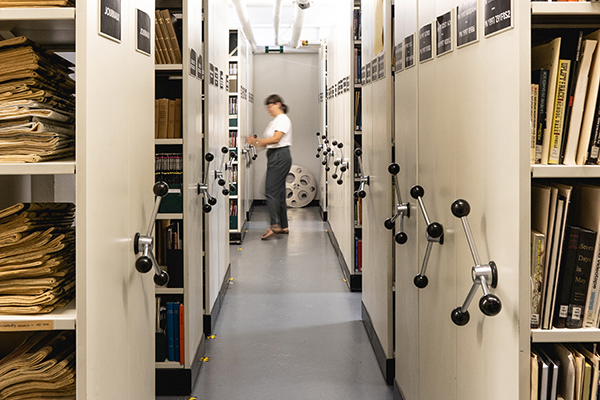Photo credit: Raphaël Thibodeau
Jessica Hébert, Head of the Collections Documentation Department at Cinémathèque québécoise, sat down with us to discuss how the right collections management system (CMS) can unlock access, integration, and preservation at scale.
Now researchers can search everything in one place. It’s made a huge difference for access.
Volume, Complexity, and Constant Change in Film Archives
Film archives face growing pressure to preserve and manage an influx of new materials across multiple formats. Jessica pointed to three core challenges faced by film archives today:
- High volume of incoming items
- Obsolete formats (both analog and digital)
- Lack of time, space, and staff to address it all
“The biggest challenge is managing the volume of records — and having the time, space, and resources to properly treat them,” she shared. Whether it’s Digital Cinema Packages (DCPs) or fragile physical media, film archives are constantly evolving to support a diversity of formats and metadata standards. Without robust infrastructure and a flexible, standards-compliant CMS, it is challenging to scale this work.
In such a complex landscape, the FIAF network provides essential peer support. “The great thing about FIAF is being able to connect with other archives and ask, What systems are you using? What workflows work for you?” said Jessica. During Cq’s migration to Axiell Collections, the team consulted other archives—including the British Film Institute (BFI)—to compare workflows, metadata standards, and software features. These conversations helped to define a clear path forward while mitigating risk.
Cinémathèque québécoise Migrates to Axiell Collections
Prior to the migration to Axiell Collections, Jessica’s team was working within a Microsoft SQL database. However, the needs of the archive had outgrown the existing system. Critical issues included:
- No unified hierarchy between film, library, and archival items
- Siloed collections that required multiple searches
- Limited support for international standards and data exports
“It followed some standards but lacked hierarchy. Film and non-film items were siloed. Nothing spoke to each other.” With Axiell, they now have a centralized film archive cataloguing system that enables unified search, better metadata control, and structured relationships across all collection types. “Now researchers can search everything in one place. It’s made a huge difference for access.”
What Makes a Collections Management System Work for Film Archives?
Jessica outlined three essential features for any CMS used in a film archive context:
- Support for international cataloguing standards, such as FIAF and RDA
- Flexibility and customization to adapt to unique institutional needs
- User-friendliness is critical for onboarding teams migrating from legacy systems
A good CMS should express the relationships between materials — across acquisitions, formats, and catalog types.
Lessons for Other Archives Planning a CMS Migration
Jessica emphasized the importance of data cleanup before any major system upgrade:
“Any cleanup you can do before the migration will save you down the line. Free-text fields, non-standard vocabularies… it all becomes a massive puzzle during implementation.” She also encouraged other institutions to be open to change: “Letting go of outdated workflows can feel difficult, but often a new way is simply better suited for the future.”
Yes, It’s Worth It — Because It’s Necessary
“Our old system was limiting us at every turn. We couldn’t support access, couldn’t export reliably, and couldn’t keep up,” Jessica said. With Axiell Collections now in place, the Cinémathèque québécoise team has modernized its infrastructure, streamlined internal processes, and significantly improved public and researcher access to its holdings.
What’s Next: Standardization and Online Access
With the migration complete, the focus has shifted to data standardization and online access. Jessica’s next steps:
- Launching their public-facing Axiell Internet Server catalog
- Syncing library records with WorldCat and international databases
- Continuing to clean and align legacy data for interoperability
Ready to Modernize Your Film Archive?
Whether you manage nitrate reels, digital formats, or a hybrid collection, Axiell Collections offers the structure, scalability, and standards support you need. Contact our team to learn more about how Axiell Collections can support your film archive’s digital transformation.




